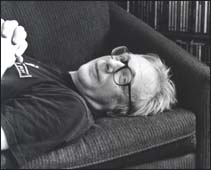Records 1/30/07

The following reviews can be founding in the current issue of Harp. Check it out.
The Shins, Wincing The Night Away
A funny thing happened to the Shins on the way to their third album: They became known. Yes, 2001’s Oh, Inverted World and 2003’s Chutes Too Narrow made the Albuquerque, N.M. natives stars of the underground, but when Natalie Portman slapped her earphones on Zach Braff and played “New Slang,” they became actual stars. For those of us who loved the Shins before Garden State, the “New Slang” scene played like a cruel joke: This was a really cool band we loved introducing to people, and here the Scrubs guy came along and ruined it. Unlike Coldplay and Death Cab for Cutie—the other unholy corners in the great indie-yuppie triumvirate—the Shins could honestly claim they had nothing to do with their newfound success, unless signing a licensing deal makes you complicit. Nevertheless, it took the band four years to make another record, and there’s no way Zach and Natalie didn’t have something to do with that. Even the title of the new album is dripping with flop-sweat: Wincing the Night Away. You’d be wincing, too, if you knew every rock fan under the age of 35 kind of wants to hate you.
But here’s another funny thing now that the Shins’ third album is finally here: They delivered. Wincing the Night Away is not a major statement. It doesn’t deviate in any major way from the first two albums. And it doesn’t totally justify the long wait. But it is the best album the Shins have made so far and, really, that ought to be enough.
The stakes are so high for Wincing the Night Away that it takes a while for the Shins to calm down. Bands caught in a similarly impossible situation in the past have typically taken one of two paths:
1) Dabble in “experimental” sounds that dress up the same old songs in Kid A-style window dressing
2) Become arena rock.
On “Sleeping Lessons,” the first track off Wincing the Night Away, the Shins somehow take both paths simultaneously. It begins with gently rolling bloops straight out of Radiohead central casting, and then it explodes into beer-friendly power chords. It’s not a bad song, per se, but it’s exactly what you fear the rest of the record will sound like. But by the time a lovely guitar solo cuts through the middle of “Australia,” the album’s bouncy second track, all worry has dissipated.
From here, the Shins pretty much pick up where they left off. OK, so there’s an irregular beat to “Sea Legs” that might be called hip-hop, and “Pam Berry” will inspire some to make a Loveless reference, but don’t let anybody tell you the Shins have re-invented their music. They’ve refined it. That may disappoint people who want something “more,” but Shins singer/songwriter James Mercer has apparently decided that the best way for his band to evolve is, simply, to write better songs. With “Phantom Limb, he’s written one of his best; the band is so relaxed and assured in the song’s undeniable melodicism that it lets the woo-wah-woo chorus go on for almost a minute, turning it into an almost-anthem. The highest compliment you can give Wincing the Night Away is that it doesn’t sound like it took four years to make. Here’s hoping it won’t be another four years until the next Shins record.
Clap Your Hands Say Yeah, Some Loud Thunder
The hipper-than-thous in Clap Your Hands Say Yeah famously cribbed from Talking Heads ’77 for their infectious 2005 debut; if only they had ripped off More Songs About Buildings And Food for the follow-up, Some Loud Thunder. While working with a producer known for aural eccentricity did wonders for the Heads on their sophomore release, Dave Fridmann (Flaming Lips, Mercury Rev) illuminates the chief weakness of Clap Your Hands: Singer Alec Ounsworth’s intolerable whine. Not that Ounsworth sounded any better on the first record, but at least the music was poppy, hooky, and likeably amateurish. Some Loud Thunder is an amateurish record pretending to be a professional record, with the seemingly directionless Claps listlessly affecting the belabored “weirdness” of Fridmann’s other famous clients. Time to call Brian Eno, fellas.



